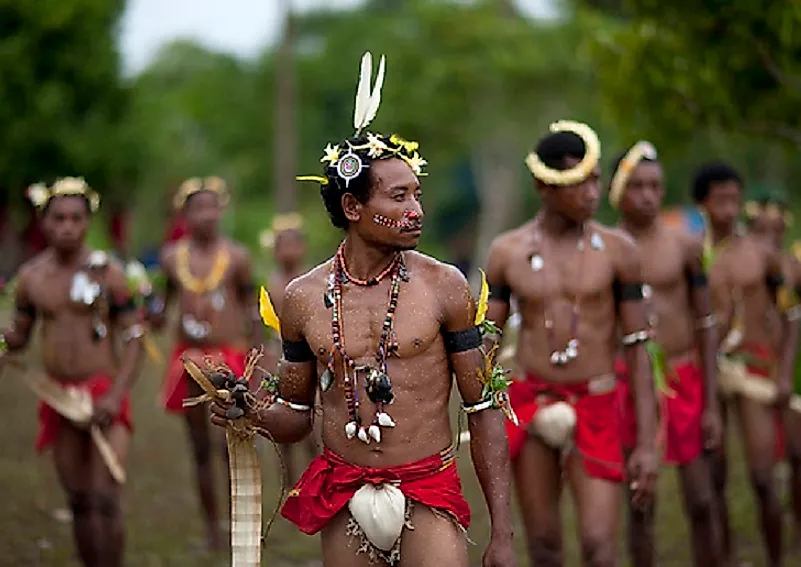The Trobrianders Of Papua New Guinea

History of the Trobrianders
The Trobrianders are an indigenous tribe living on the Trobriand Islands archipelago of Papua New Guinea. These islands were first reached by the French in 1793 and are, in fact, named after the lieutenant of the ship. This first discovery did not result in colonization, however. A Methodist missionary came to the Kiriwina island in 1894 and around 10 year later, Australian colonial officers established a government station here. This was followed by a small colony of foreign traders. In the 1930’s, a Catholic mission arrived and set up a primary school. Under Australian colonial rule for 70 years and faced with various attempts at religious conversion, the Trobrianders have remained resistant to change. During the 1970’s, the indigenous islanders began anti-colonial movements that won them their independence in 1975.
Current Population
The current population is estimated to total around 12,000. The majority of these individuals live on the Kiriwina island, one of the 4 largest in the archipelago. They survive on subsistence agriculture and fishing, which they do from handmade wooden boats. The islanders live in traditional villages, made up of 2 to 8 groups of 6 to 20 houses. The houses are built of wood with grass roofs and sit raised above the ground to avoid flooding during rainy season.
Families continue to trace their ancestry through one of four matrilineal lines thought to exist on the islands. Chiefs are chosen based on matrilineal birthright as well. Marriage cannot occur between two people from the same matrilineal family and so partners are chosen from paternal side of the family.
Settling Disputes With a Game of Cricket
Under colonial rule, inter-tribal war was prohibited. At the same time, missionaries introduced the game of cricket to the tribes. The Trobrianders quickly adapted the game with a larger number of players, different bats and balls, and adding chants and dances. Today, the game is played in order to settle disputes, one of the few, lasting changes from colonialism.
Language
Kilivila is the shared language of the Trobriand Islanders. Different tribes speak different dialects which is largely dependent on their location. It is a Kilivila-Louisiades language from the Austronesian language family. Linguists report that the language has a complex noun classification system. Interestingly, Kilivila is also a non-linear language. This means that the concept of time progression, shapes, and descriptions are either non-existent or different from western languages.
Economy
The Trobriand Islanders use dried banana leaves and yams as currency because these are their most important crops. Yams, in particular, are a sign of power and wealth. Men cultivate yams and give them to their sisters, never their wives. This ensures that children are provided for by the maternal family. The amount of yams that a woman receives is an indicator of her power and worth.
Colonial attempts at establishing cash crops on the islands were unsuccessful, as the tribes traditionally have relied upon non-monetary bartering. The biggest trading system is called “kula”, and it involves tribal chiefs traveling by canoe among the islands. This is done in order to establish friendly relations among tribes. Red shell necklaces are traded in the northern islands and white shell armbands in the south. Possession of these items brings prestige to the owner, although, ownership is brief and the items continue to be circulated throughout the trading ring. They are never sold, and the kula practice is not meant for financial gain.
During the 1970’s tourism was popular, which led to an increased production and selling of wood carvings from the islands. Visitors to the island, however, have decreased in recent decades. Women also trade for goods by using dried banana leaves, allowing them to purchase such items as kerosene, cloth, and tobacco without legally tendered money.
Cuisine
Trobriand Island crops include yams, bananas, taro, sugarcane, beans, squash, leafy greens, and coconuts. Meals are eaten in private. In Trobriand Islander culture, eating in front of somebody is taboo. If people are in the same area together while eating, they do so quickly and with their backs turned to each other. Having an abundance of food is also important because it denotes success. Unfortunately, food insecurity is an issue the Trobrianders face every harvest season.
Unique People, Customs, and Beliefs
Despite the cultural influence of colonists and missionaries, the Trobrianders continue to hold onto many unique customs and beliefs. Magic plays an important role in their society and anybody can practice a spell. Spells can be traded or sold and range from encouraging love to inducing beauty. Magic, it is believed, is also responsible for pregnancies. Trobrianders believe that ancestral spirits enter women’s bodies, leaving behind babies.
Trobrianders also have a very liberal attitude in regard to sexual relations, and begin participating in such acts at very young ages by Western standards. This behavior is encouraged among the community and villages even have a special house called a “bukumatula”, which is designated specifically for these encounters. Marriage is established when a woman stays in the man’s hut after sunrise. The woman’s mother then brings them yams, which they eat together in order to formalize the relationship.











